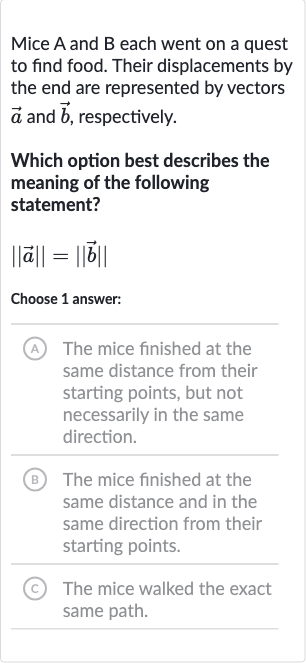AI tutor
Welcome to Bytelearn!
Let’s check out your problem:

Mice and each went on a quest to find food. Their displacements by the end are represented by vectors and , respectively.Which option best describes the meaning of the following statement?Choose answer:(A) The mice finished at the same distance from their starting points, but not necessarily in the same direction.(B) The mice finished at the same distance and in the same direction from their starting points.(C) The mice walked the exact same path.
Full solution
Q. Mice and each went on a quest to find food. Their displacements by the end are represented by vectors and , respectively.Which option best describes the meaning of the following statement?Choose answer:(A) The mice finished at the same distance from their starting points, but not necessarily in the same direction.(B) The mice finished at the same distance and in the same direction from their starting points.(C) The mice walked the exact same path.
- Magnitude of a vector: The magnitude of a vector represents the distance from the starting point to the end point, without considering direction.
- Equality of magnitudes: The statement means that the magnitudes of and are equal.
- Implication of equal magnitudes: Since only the magnitudes are equal, this implies that the distances traveled by mice and are the same.
- Consideration of direction: However, the statement does not provide any information about the direction of the vectors. Therefore, we cannot conclude that the mice traveled in the same direction.
- Correct conclusion: The correct answer is (A) The mice finished at the same distance from their starting points, but not necessarily in the same direction.
More problems from Transformations of absolute value functions: translations and reflections
QuestionGet tutor help
QuestionGet tutor help
QuestionGet tutor help
QuestionGet tutor help
QuestionGet tutor help
QuestionGet tutor help
QuestionGet tutor help
QuestionGet tutor help
QuestionGet tutor help
